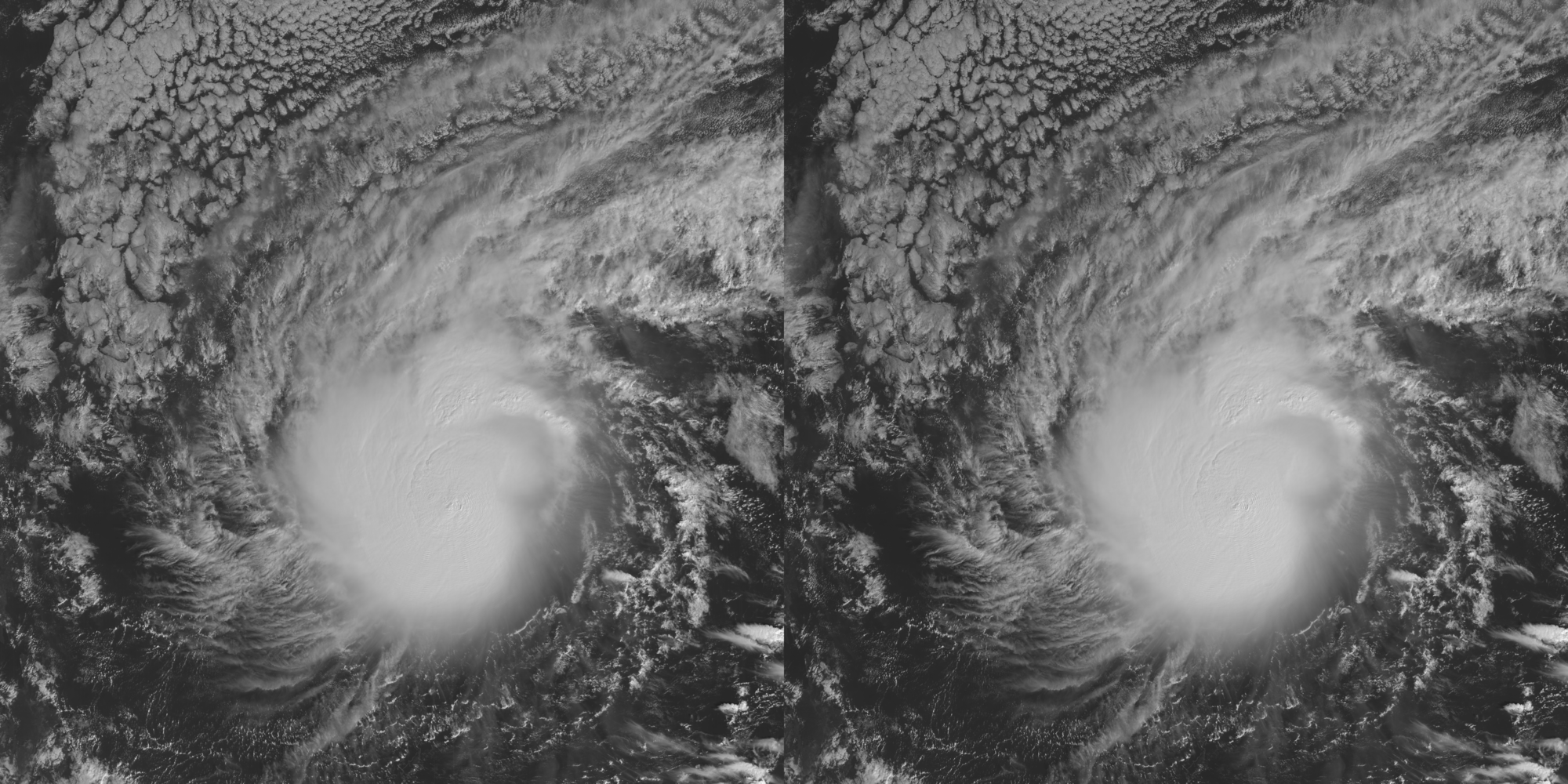Typhoon Kammuri in the West Pacific Ocean, with record cold cloud-top temperatures
Himawari-8 “Clean” Infrared Window (10.4 µm) images [click to play animation | MP4]
Plots of the coldest overshooting top 10.4 µm brightness temperatures on Himawari-8 Target Sector (2.5-minute interval) and Full Disk (10-minute interval) images during the 0002-0502 UTC time period on 30 November (below) showed that the closest (in time**) Full Disk image BTs were often within a degree C of the Target Sector images — but the magnitude of rapid fluctuations of BT seen in the 2.5-minute data were well not captured by the 10-minute data. For the 4 Target Sector images exhibiting BTs of -103ºC and colder (0112, 0127, 0204 and 0259 UTC) only one of the closely-corresponding Full Disk images exhibited a similarly cold BT (0110 UTC, with -103.0ºC). The coldest Target Sector BT was -103.55ºC at 02:59:44 UTC, while the coldest Full Disk BT was -103.0ºC at 01:13:34 UTC.
**The actual time that closely-corresponding Target Sector and Full Disk scans were imaging Kammuri differed by about 1 minute and 15 seconds — for example, the 01:12:15 UTC Target Sector scanned Kammuri’s coldest overshooting tops at 01:12:19, while the 01:10:00 Full Disk scanned those same overshooting tops at 01:13:34 UTC.
![Plots of coldest Himawari-8 10.4 µm brightness temperatures on 2.5-minute Target Sector (blue) and 10-minute Full Disk (green) images [click to enlarge]](https://cimss.ssec.wisc.edu/satellite-blog/wp-content/uploads/sites/5/2019/11/191130_Himawari8_Kammuri_IRBT.png)
Plots of coldest Himawari-8 infrared (10.4 µm) brightness temperatures on 2.5-minute Target Sector (blue) and 10-minute Full Disk (green) images [click to enlarge]
![NOAA-20 VIIRS Infrared Window (11.45 µm), with different color enhancements (credit: William Straka) [click to enlarge]](https://cimss.ssec.wisc.edu/satellite-blog/wp-content/uploads/sites/5/2019/11/191130_0420utc_noaa20_viirs_infrared_Kammuri_anim.gif)
NOAA-20 VIIRS Infrared Window (11.45 µm) image at 0421 UTC, with 2 different color enhancements (credit: William Straka, CIMSS) [click to enlarge]
Himawari-8 “Red” Visible (0.64 µm) images [click to play animation | MP4]
—————————
![Suomi NPP VIIRS Day/Night Band (0.7 µm) and Infrared Window (11.45 µm) images at 1604 UTC [click to enlarge]](https://cimss.ssec.wisc.edu/satellite-blog/wp-content/uploads/sites/5/2019/11/191130_1604utc_suomiNPP_dayNightBand_infraredWindow_Kammuri_anim.gif)
Suomi NPP VIIRS Day/Night Band (0.7 µm) and Infrared Window (11.45 µm) images at 1604 UTC (credit: William Straka, CIMSS) [click to enlarge]
![NOAA-20 Day/Night Band (0.7 µm) and Infrared Window (11.45 µm) images at 1654 UTC (credit: William Straka, CIMSS) [click to enlarge]](https://cimss.ssec.wisc.edu/satellite-blog/wp-content/uploads/sites/5/2019/11/191130_1654utc_noaa20_dayNightBand_infraredWindow_Kammuri_anim.gif)
NOAA-20 Day/Night Band (0.7 µm) and Infrared Window (11.45 µm) images at 1654 UTC (credit: William Straka, CIMSS) [click to enlarge]
—————————
Himawari-8 Water Vapor (6.2 µm) images with contours of Deep-Layer Wind Shear (above) indicated that Kammuri was moving through an environment of low to moderate shear. Himawari-8 Water Vapor images with plots of satellite-derived Atmospheric Motion Vectors (below) showed a well-defined outflow channel north of the tropical cyclone.Himawari-8 (courtesy JMA) and GEO-KOMPSAT-2A or GK2A (courtesy KMA) visible imagery were combined to create stereoscopic imagery of the storm on 30 November, as shown below from 2100 UTC on 29 November to 0820 UTC on 30 December. View the 3-dimensional image by crossing your eyes and focusing on the third image that becomes apparent in between the two images shown.

Visible (0.64 µm) Imagery from Himawari-8 (left) and GK2A (right) from 2100 UTC on 29 November to 0820 UTC on 30 November 2019 (Click to animate)
10-minute Full Disk images of GK2A Cloud Top Temperature and Cloud Top Height products (source) are shown below. A large canopy of CTT values as cold as -80ºC and CTH values up to 15 km were seen associated with Typhoon Kammuri during the period 0000-0500 UTC.
![KMA GK2A Cloud Top Temperature product [click to play animation | MP4]](https://cimss.ssec.wisc.edu/satellite-blog/wp-content/uploads/sites/5/2019/11/gk2a_ami_le2_ctps-ctt_fd020ge_201911300300.srv.png)
KMA GK2A Cloud Top Temperature product [click to play animation | MP4]
![KMA GK2A Cloud Top Height product [click to play animation | MP4]](https://cimss.ssec.wisc.edu/satellite-blog/wp-content/uploads/sites/5/2019/11/gk2a_ami_le2_ctps-cth_fd020ge_201911300300.srv.png)
KMA GK2A Cloud Top Height product [click to play animation | MP4]


![NOAA-20 VIIRS True Color RGB and Infrared Window (11.45 µm) images at 0420 UTC [click to enlarge]](https://cimss.ssec.wisc.edu/satellite-blog/wp-content/uploads/sites/5/2019/11/191130_0420utc_noaa20_trueColorRGB_infraredWindow_Typhoon_Kammuri_anim.gif)
![Himawari-8 Visible (0.64 µm) and Infrared (10.4 µm) images at 0422 UTC [click to enlarge]](https://cimss.ssec.wisc.edu/satellite-blog/wp-content/uploads/sites/5/2019/11/191130_0422utc_himawari8_visible_infrared_Kammuri_overshooting_tops_anim.gif)
![6.9 µm) images, with contours of Deep-Layer Wind Shear [click to enlarge]](https://cimss.ssec.wisc.edu/satellite-blog/wp-content/uploads/sites/5/2019/11/191130_Himawari8_waterVapor_deepLayerWindShear_Kammuri_anim.gif)
![Himawari-8 Water Vapor (6.9 µm) images, with Derived Motion Winds [click to enlarge]](https://cimss.ssec.wisc.edu/satellite-blog/wp-content/uploads/sites/5/2019/11/191130_Himawari8_waterVapor_derivedMotionWinds_Kammuri_anim.gif)